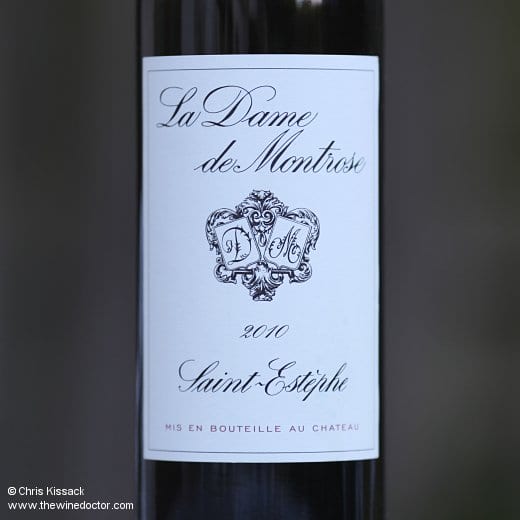La Dame de Montrose 2010
Having recently returned from Bordeaux, my head was full of thoughts on Bordeaux 2013 last week. I have also tasted plenty of 2011 Bordeaux recently, both in the region and at the UGC tasting in London, along with one or two wines from 2012, either poured instead of the 2011 (such as at Petrus) or alongside (such as at Château Lafleur) which made for a fascinating comparison. Add in the fact that later this week I will be getting to grips with the 2009 Bordeaux vintage again, to be presented at the Institute of Masters of Wine in London now that it is four years of age, and it has been (or is about to be) something of a Bordeaux vintage-fest.
Except that I haven’t mentioned 2010 yet, and every time I encounter one of these wines I am more and more enamoured with the vintage. I think it is a vintage every fan of Bordeaux should have in their cellar. That’s a little different to 2009 Bordeaux, which is vintage simply everybody should have in their cellar, including those who are unaware taht there is wine made outside the confines of Vosne-Romanée, Barolo or Coonawarra. The 2009 vintage is the current generation’s 1961 I think, set to be vaguely mythical, and even if that doesn’t interest you at the value end it is also very, very useful. The 2010 vintage, meanwhile, is set to give stacks and stacks of pleasure to those of us who love more classically structured Bordeaux, full of tannin and fresh acidity as well as fruit and texture.

Having recently added some bottles to the cellar, including almost every wine I had my eye on since my en primeur and first in-bottle tastings (I still must add some Château Gloria though), I thought I would do something I don’t often do – because I taste so much young Bordeaux, and nowhere near enough mature Bordeaux – and simply pop the cork on one of them straight away. In a selection that ranged from Château Grand-Puy-Lacoste, one of the most beautiful and precisely structured wines of the vintage, down to G Acte 2, the Bordeaux Supérieur from the Guinaudeau family (I figure this is probably the closest I will ever come to the elegance of Château Lafleur, and its price is matched much more in keeping with my income than that of Lafleur!) the obvious choice seemed to me to be the 2010 La Dame de Montrose. I think Château Montrose has been on sterling form in recent vintages, and although I don’t think I will be filling the cellar with it (for the same reason my cellar isn’t brimming over with Lafleur), I certainly find the second wine to be within my reach.
My disdain for second wines has faded considerably over the last few years. A positive side effect of the chase for ever higher-prices by the Bordelais has been more and more ruthless selection; it is now not uncommon for 60% or even 70% of the harvest to be channelled into the second wine, leaving just the crème de la crème – a super-cuvée, if you will – for the grand vin. This means many vats once destined for the first wine now find their way into the second; while I have somewhat philosophical misgivings about this (see my guide to the second and third wines of Bordeaux for more detail) I’m not about to let them get in the way of enjoying the new quality that these wines offer. This much is evident in the 2010 La Dame de Montrose, which as you might imagine for a wine of this age, still has a very dense, glossy hue, dark almost all the way out to the edge, leaving a thin rim of vibrant, crimson-hued wine. Aromatically it has smoke, blackberries and a perfumed tinge of violets swirled around the periphery and then, from beyond the primary floral-fruit, comes more nuanced and less typical characters, dried currants, dark chocolate and leathery spice. The palate is pure, svelte and textured at the start, and this poise and substance is carried through the middle and end, leaving a long seam of tense, vibrant, ripe but crunchy fruit on the finish, which to me seems very appropriate for the 2010 vintage. The flavours mirror the nose, the acid bright and firm as I would expect, the tannins svelte and surprisingly approachable; they certainly make their presence felt in the mouth, but they are ripe and polished, and do not detract. This is an excellent second wine, performing at the top of my primeur score range, and proof that second wines should no longer be summarily disregarded. 17.5/20 (4/11/13)
